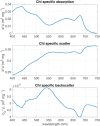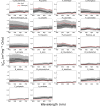Simulated Inherent Optical Properties of Aquatic Particles using The Equivalent Algal Populations (EAP) model
- PMID: 37355642
- PMCID: PMC10290707
- DOI: 10.1038/s41597-023-02310-z
Simulated Inherent Optical Properties of Aquatic Particles using The Equivalent Algal Populations (EAP) model
Abstract
Paired measurements of phytoplankton absorption and backscatter, the inherent optical properties central to the interpretation of ocean colour remote sensing data, are notoriously rare. We present a dataset of Chlorophyll a (Chl a) -specific phytoplankton absorption, scatter and backscatter for 17 different phytoplankton groups, derived from first principles using measured in vivo pigment absorption and a well-validated semi-analytical coated sphere model which simulates the full suite of biophysically consistent phytoplankton optical properties. The optical properties of each simulated phytoplankton cell are integrated over an entire size distribution and are provided at high spectral resolution. The model code is additionally included to enable user access to the complete set of wavelength-dependent, angularly resolved volume scattering functions. This optically coherent dataset of hyperspectral optical properties for a set of globally significant phytoplankton groups has potential for use in algorithm development towards the optimal exploitation of the new age of hyperspectral satellite radiometry.
© 2023. The Author(s).
Conflict of interest statement
The authors declare no competing interests.
Figures








References
-
- Bernard S, Probyn TA, Quirantes A. Simulating the optical properties of phytoplankton cells using a two-layered spherical geometry. Biogeosciences Discussions. 2009;6:1.
Publication types
LinkOut - more resources
Full Text Sources

